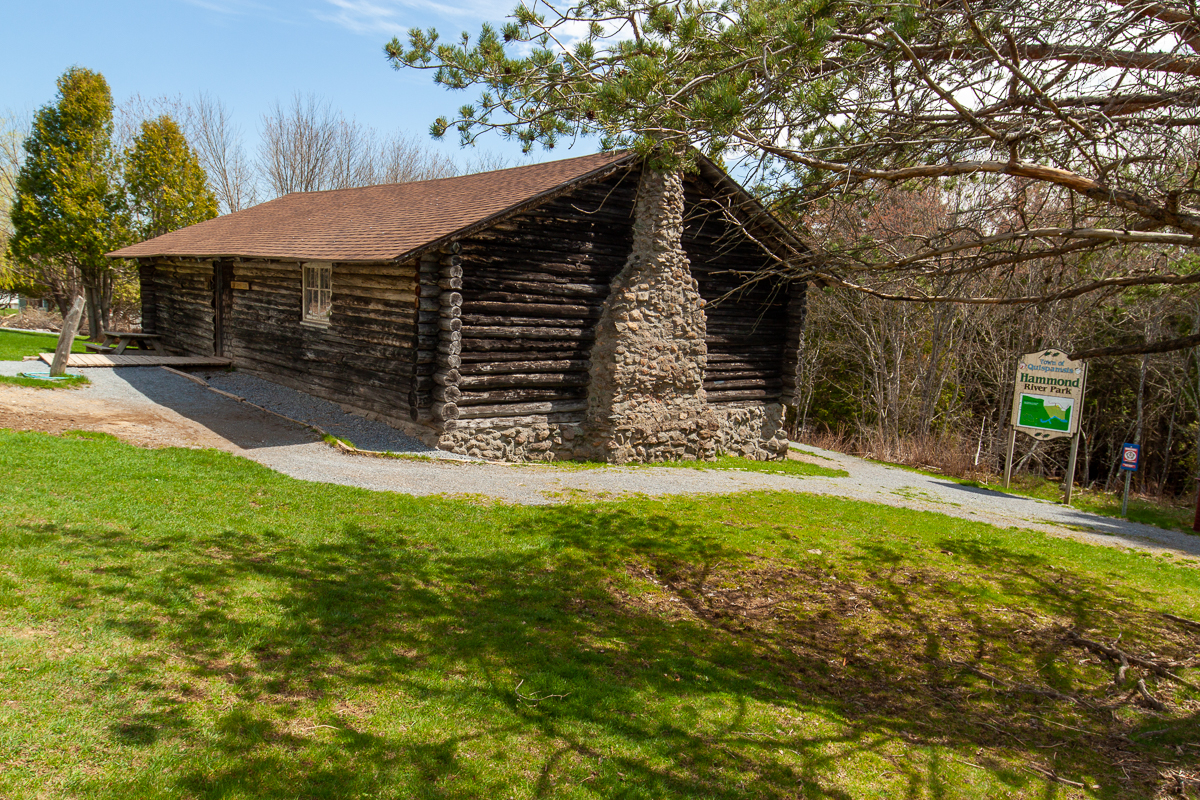Hammond River Park Trails
Video
Quick Facts
| Difficulty | easy-moderate |
| Trail Type | loop |
| Distance | 3.9 km |
| Estimated Time | 1 hr 30 mins |
| Surface Type | crushed rock, forested |
| Elevation Change | 68 meters |
| Features | river, forest |
| Trail Markers | colored hiker signs |
| Scenery Rating | beautiful |
| Maintenance Rating | well maintained |
| Cell Reception | strong |
| Dog Friendly | yes |
| Fees | none |
Description
The trails start behind a historic log cabin. The land that the park is on has been settled for over 300 years. When the park was being developed an Acadian survey marker was found that is dated 1714.
The Otty Glen Loop Trail is a wide crushed rock trail that goes down the hill and then follows along the river. When I was there last there was spring flooding that covered part of the trail. Near the river there are sections of boardwalks over wet areas. The trail travels through mixed forest that changes into mostly cedar. The cedar are growing on and around small boulders along the trail. Eventually the trail climbs the hill away from the river and returns to the cabin.

The Jubilee Loop Trail is a single track trail that goes more directly down the hill and back up again making it more steep. The climb down the hill on the southern end has many stairs. The climb back up the hill to the north climbs up through a rocky cedar forest with a bench about half way up the hill.
There are several other trails called the Ironwood Pass and Green Ash Lane that climb the hill more gradually along the top and bottom of a ridge that runs through the park. The ridge is made up of large boulders and small cliffs.
There are several other old trails that criss-cross the park but they are all contained within the main Otty Loop Trail making it difficult to get lost. Most of the old trails explore the cliffs and rocky outcrops on the ridge.

Map
From the Sign
Skunk Cabbage
Symplocarpus foetidus. Skunk cabbage can be found in wetlands and along low-lying streams. It is a rare plant in New Brunswick but it is more common in the Hammond River Watershed. Skunk cabbage is a thermogenic plant that can produce heat up to 25 degrees celsius, allowing it to flower very early in the spring. The flower of this plant releases a rotten meat scent that attracts pollinators. Its leaves release a skunk-like scent when broken or bruised, to deter insects and herbivores. While smelling this plant is harmless, eating the leaves of this plant will cause swelling of the mouth and digestive tract!

From the Sign
Sphagnum Moss
Sphagnum spp. Commonly known as peat moss, Sphagnum is commonly found in bogs and other wetlands. These plants have porous cells and can hold up to 26 times their dry weight in water. When peat accumulates it can form bogs, and provide habitat for a wide array of plants, including carnivorous species. Peat can accumulate to a depth of many meters, and can acidify its surroundings. Native Americans used peat moss for diaper material and baby wipes. Peat moss is important commercially as a soil conditioner, as it helps to retain moisture and nutrients.
External Links
Directions
From Gondola Point Arterial Road in Quispamsis travel north on route 100. After 1.4 kilometres continue straight on the Model Farm Road. Drive for another 5.7 kilometres until you come to a junction with Hammond River Road. Turn left and then keep right onto Neck Road. After 800 metres turn right onto Reynar Drive. After 400 metres turn right into the park.
From the Sign
Eastern White Cedar
Thuja occidentalis. Eastern white cedar is a favoured winter food and shelter species of white tailed deer. Found in calcium rich soils, eastern white cedar is valued commercially for its rot and insect resistant properties. An important part of Canadian heritage, aboriginals demostrated to Jacques Cartier that eastern white cedar leaves can be used to combat scurvy due to their high vitamin C content.
From the Sign
Ironwood
Ostrya Virginiana. Also known as Hop-Hornbeam, Ironwood trees have the hardest and densest wood of any species in Canada. The wood is valued for firewood, tool handles, fence posts and is an excellent material for wooden longbows. Ironwood can be identified by the shaggy, narrow strips of bark that are said to look like fried bacon as they peel. The buds and catkins are an important source of winter food for ruffed grouse and other birds.
From the Sign
Pileated woodpecker
Dryocopus pileatus. The Pileated woodpecker is the largest woodpecker in Canada, measuring 49cm. The call is a loud, far-carrying laugh. Its drumming (or pecking) is very loud, like someone striking a tree with a hammer. Pileated woodpeckers chip out large rectangular holes in trees while searching out insects, that they lap up with their long tongues. They also excavate large nests in the cavities of dead trees which later become homes of a wide variety of other animals. Owls and tree-nesting ducks may largely rely on holes made by pileateds for nesting.
From the Sign
Apple Tree
Malus spp. belongs to the rose family which includes: apricot, cherry, peach, pear, plum, raspberry, strawberry and rose. This tree did not evolve naturally; rather it has been domesticated and planted around the world for thousands of years. The wild ancestors of Malus come from Asia. Mature Apple trees indicate that this park was once an open pasture, colonized by humans who planted these trees.
From the Sign
Red-backed Salamander
Plethodon cinereus. The red-backed salamander is common in wooded slopes. Breeding occurs in June and July and females produce 4-17 eggs per year. Unlike most salamanders that lay eggs in water and have an aquatic larval phase, the red-backed salamander nests in a rotten stump or log. When the larvae first hatch, they have small gils, but these are soon absorbed and the young then resemble adults. Females protect the eggs for 6-8 weeks and remain with their young for up to 3 weeks.
Other Trails in the Town
Trail Last Hiked: May 10, 2018.
Page Last Updated: October 14, 2019.


